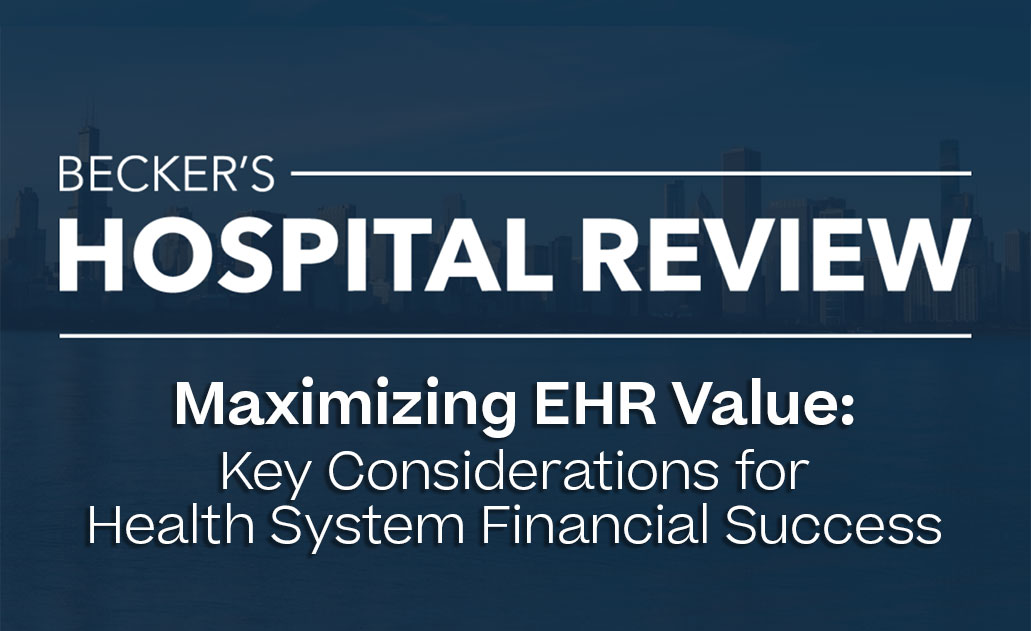November 1st, 2024 / News
Maximizing EHR Value: Key Considerations for Health System Financial Success

Electronic health records (EHRs) play a crucial role in both clinical care and financial management in healthcare today. As hospitals and health systems face rising costs and persistent labor shortages, choosing the right EHR system becomes increasingly critical. To maximize return on investment and avoid hidden costs, healthcare leaders must carefully evaluate potential EHR vendors while considering how these systems can revolutionize revenue cycle management (RCM).
Transparency in Cost and Implementation
When evaluating EHR vendors, transparency is paramount. Healthcare organizations should seek a detailed breakdown of all costs associated with the system, including software, hardware, data migration, implementation, staff augmentation, and ongoing support. It’s essential to understand the total cost of ownership from contract signing to renewal and to clarify any potential third-party costs.
A vendor that offers a comprehensive “System as a Service” model, which includes all components of implementation, hardware, software, and system utilization, bundled together for a fixed price provides the greatest value. This approach provides greater cost clarity and reduces long-term expenses.
Adaptability and Interoperability
An effective EHR should offer a flexible architectural framework that seamlessly addresses evolving challenges of interoperability, scalability, and real-time performance data, futureproofing for continuous innovation. The system should provide a real-time comprehensive longitudinal patient record that seamlessly crosses multiple sites and environments, adapting to changing data needs for today and over time.
Staffing Considerations
Healthcare organizations often underestimate the staff required to implement and manage an EHR system. With ongoing clinical and IT staffing challenges, it’s crucial to understand a vendor’s staffing requirements and support services. Look for systems that offer robust out-of-the-box solutions that can be customized, are intuitive and user-friendly, and provide 24/7 end-user support to minimize the burden on clinical and IT staff.
System and Medical Device Integration
Ensure that the EHR vendor includes comprehensive data migration and integration capabilities for systems, devices, and other technologies. Understanding the costs and limitations of current and future integrations is critical for maintaining interoperability standards and providing a true real-time longitudinal patient record.
Mitigating Operational Disruptions
Choose an EHR solution that delivers 100% uptime for maintenance, upgrades, and unplanned incidents. This level of reliability is essential for avoiding clinical dissatisfaction, poor patient care, and financial losses.
Revolutionizing Revenue Cycle Management
A fully integrated EHR that combines clinical and financial processes can significantly improve operational efficiency and streamline workflows. By automating tasks such as charge capture, coding, and claim adjustments, EHRs can reduce the burden on staff while enhancing accuracy and compliance.
Integrated EHRs can also provide valuable data-driven insights for optimizing revenue cycle performance. These systems can offer actionable intelligence on key metrics such as cost to collect, days in accounts receivable, and clean claim rates, allowing revenue cycle leaders to identify areas for improvement and address bottlenecks.
Enhancing the Patient Experience and Financial Engagement
Modern EHRs should create a seamless experience for patients, from registration through clinical care and payment. With patient payments becoming a larger percentage of overall hospital revenue, it’s essential to offer convenient options for scheduling appointments, completing forms, and paying bills. Features such as text-to-pay reminders and upfront patient estimates can improve patient satisfaction and accelerate payments.
Choosing the right EHR system is a pivotal decision with far-reaching implications for both clinical care and financial health. By carefully evaluating vendors based on transparency, adaptability, staffing impact, integration capabilities, and operational reliability, healthcare organizations can select a system that not only meets their clinical needs but also optimizes their revenue cycle management and overall operations.
The ideal EHR should seamlessly integrate clinical, administrative, and financial processes, leveraging automation and analytics to improve efficiency, reduce costs, and alleviate the burden on staff. By embracing a comprehensive, patient-centric approach to EHR implementation, healthcare providers can navigate financial challenges more effectively while delivering superior care and financial efficacy for their patients.
